ERS Charts of Note
Subscribe to get highlights from our current and past research, Monday through Friday, or see our privacy policy.
Get the latest charts via email, or on our mobile app for  and
and 
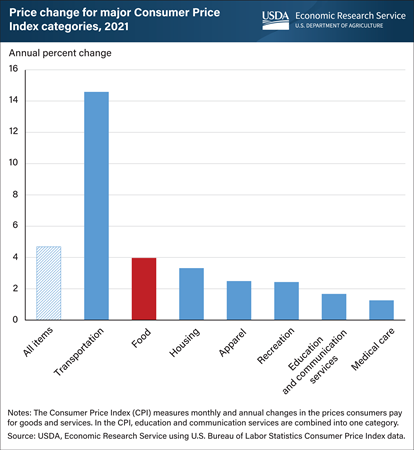
Wednesday, February 23, 2022
Food prices overall increased by an average of 3.9 percent in 2021 compared to 2020, the highest annual increase since 2008. Food prices grew more slowly than the “all items” and transportation CPIs, but more quickly than all other of the “major groups” tracked by the U.S. Bureau of Labor Statistics (BLS). The CPI for all items rose 4.7 percent in 2021. Among the food categories that comprise the food CPI, the food-away-from-home (restaurant purchases) CPI increased 4.5 percent, compared with an increase of 3.5 percent for food-at-home (grocery stores or other purchases from food retailers). The highest price increases in food-at-home categories in 2021 were for beef and veal (9.3 percent), pork (8.6 percent), and fresh fruit (5.5 percent). Using the CPI data, USDA, Economic Research Service (ERS) researchers project overall food prices will increase between 2 and 3 percent in 2022. A five-year comparison of changes in major CPI categories is available in the Food Prices and Spending section of ERS’s Ag and Food Statistics: Charting the Essentials data product, and a time-series visualization of the data appears in the Food Price Environment data tool. More information on ERS’s monthly food price forecasts can be found in ERS’s Food Price Outlook (FPO) data product. The next FPO release is February 25, 2022.
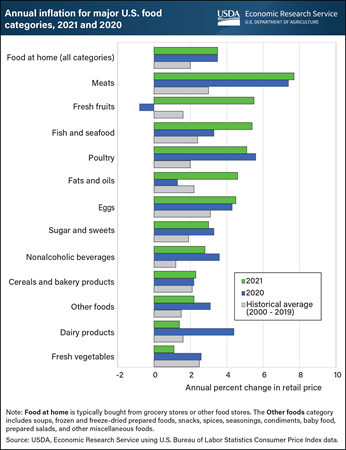
Friday, January 28, 2022
Retail food prices increased by 3.5 percent in 2021, equal to the rate in 2020 and greater than the historical annual average of 2.0 percent from 2000 to 2019. Of the 12 food categories depicted in the chart, six showed slower price increases in 2021 compared with 2020. Dairy products and fresh vegetables, in particular, had significantly slower price increases in 2021 than 2020 and their historical averages. Dairy product prices increased at 1.4 percent in 2021 versus 4.4 percent in 2020 and fresh vegetable prices increased by 1.1 percent compared to 2.6 percent is 2020. Conversely, prices in six food categories increased in 2021 at a faster rate than in 2020 as well as in years prior. Prices for fresh fruits, for instance, increased 5.5 percent in 2021 compared to a 0.8-percent decrease in 2020 and a 1.6-percent average increase over the prior 20 years. Inflationary pressures differ by food category. For example, meat prices, which rose the most of any included product groups, have been driven up by strong domestic and international demand, high feed costs, and supply chain disruptions. Winter storms and drought impacted meat prices in the spring, and processing facility closures due to cybersecurity attacks affected beef and other meat production in May. USDA, Economic Research Service (ERS) researchers project that prices for food-at-home, or food purchased typically from grocery stores or other food stores, will increase between 1.5 and 2.5 percent in 2022, lower than the 3.5-percent increase that occurred in both 2020 and 2021. Forecasts for all food categories for 2022 are available in ERS’s monthly Food Price Outlook data product, updated January 25, 2022.
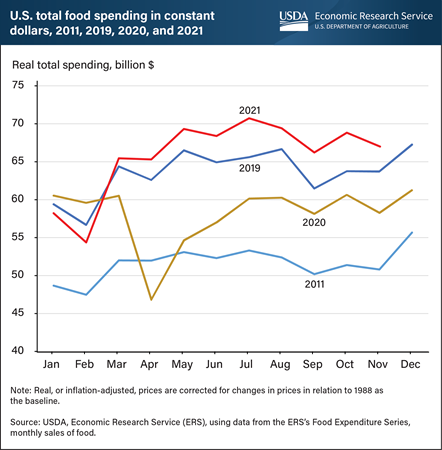
Friday, January 21, 2022
Total food spending in the United States generally follows seasonal trends. The lowest food spending levels usually occur in January and February, before rising in March and remaining at this higher level through August. Spending then drops from September through November before peaking during the December holidays. However, food economy disruptions following the onset of the Coronavirus (COVID-19) pandemic in early 2020 altered historical monthly food spending trends in the United States. The USDA, Economic Research Service’s (ERS) Food Expenditure Series tracks food spending beginning in 1997. The largest monthly decline in food spending (23 percent) occurred in April 2020, and monthly food spending averaged 8.3 percent lower in 2020 than in 2019. Overall, total U.S. food spending has consistently increased over the years, even when accounting for inflation. Average inflation-adjusted monthly expenditures were 23.2 percent higher in 2019 than in 2011. Though total food spending in 2021 has followed the typical pattern, spending began the year below pre-pandemic levels but surpassed previous years beginning in March. The data for this chart come from the ERS’s Food Expenditure Series data product.
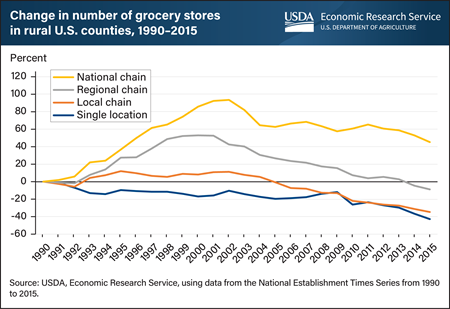
Friday, December 3, 2021
From 1990 to 2015, rural U.S. counties saw a noticeable change in the numbers and types of food retailers serving consumers, according to a recent USDA, Economic Research Service (ERS) report. Researchers separated grocery stores—the most common type of food retailer—into four categories: single location, local chain, regional chain, and national chain. In rural counties, national chains were the only grocery stores that increased in numbers over the 25 years, rising by 45.2 percent. While single location grocery stores outnumbered the three other types in rural counties, they demonstrated the deepest decline with a 42.7 percent drop. The sharpest decline happened after 2009. The reduction in the number of single location stores drove an overall decline in the total number of grocery stores. Local chains decreased by 34.7 percent, and regional chains by 8.9 percent. This chart appears in the ERS report The Food Retail Landscape Across Rural America, released June 2021.
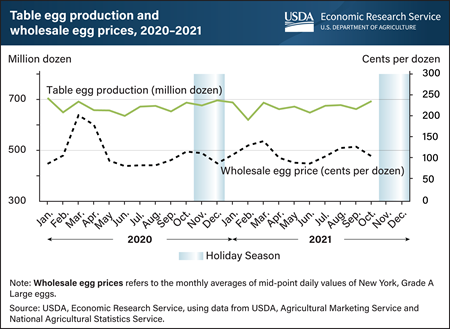
Tuesday, November 30, 2021
Demand for table eggs tends to increase when holiday gatherings and cold weather encourage home baking and cooking. In accordance, wholesale table egg prices—the prices retailers pay to producers for eggs—tend to increase ahead of holidays such as Thanksgiving, Christmas, and Easter. Leading up to the 2021 holiday season, however, wholesale prices of table eggs in the United States have fallen as effects of Coronavirus (COVID-19)-linked flock adjustments linger. In normal years, producers anticipate seasonal demand by adjusting the size of the table-egg laying flocks and the rate at which they produce eggs. In 2020, COVID-19-related disruptions in the demand for eggs led producers to reduce flock sizes. Flock sizes have slowly rebuilt since the summer of 2020 but remain smaller than the same time in 2019. However, the younger flocks produce more eggs per hen. The higher productivity can offset the effects of the small flock size and support increased production. At the beginning of October 2021 the size of the U.S. laying flock was just above the October 2020 levels and the rate of lay was 1.1 percent higher. This productivity bump is predicted to support about a 1 percent increase in October 2021 table egg production compared with a year ago, leading to a 9.6 percent price reduction compared to October 2020. This chart is drawn from the USDA, Economic Research Service Livestock, Dairy, and Poultry Monthly Outlook, published November 2021.
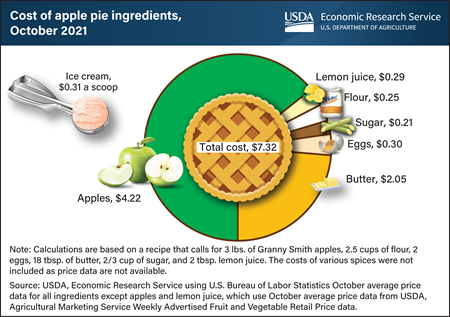
Monday, November 22, 2021
As U.S. consumers finalize their Thanksgiving menus, they might be curious to know how much ingredients will likely cost. If a homemade apple pie is on the menu, consumers can expect to pay about $7.32 for the ingredients, more than half of which ($4.22) is for apples. The same pie ingredients cost about $6.75 last year, meaning the total cost is 8.4 percent higher this year. The cost increase is driven by the price of Granny Smith apples, which increased from an average $1.26 per pound in October 2020 to $1.41 per pound in October 2021. Sugar, eggs, butter, and lemons also increased in price over the same period, while flour prices decreased. If the apple pie is served a la mode, plan to factor in an additional $0.31 per scoop, the same price as in 2020. USDA, Economic Research Service used average price data from the U.S. Bureau of Labor Statistics and USDA, Agricultural Marketing Service Weekly Advertised Fruit and Vegetable Retail Price data to derive the cost for the ingredients of an apple pie. The most recent data points are from October, meaning prices for Thanksgiving week may vary; savings may occur if grocers offer holiday discounts. Forecasts for aggregate food category prices can be found in the Food Price Outlook data product, which will next be updated on November 23.
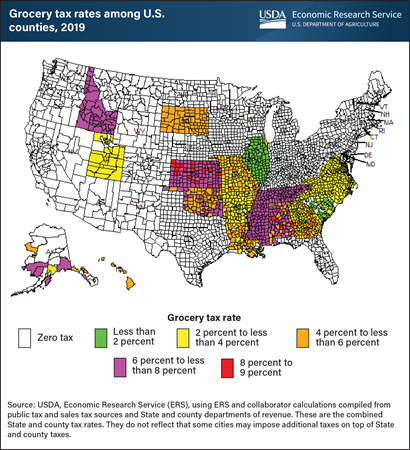
Friday, November 5, 2021
Foods purchased at grocery stores, supercenters, and other retail venues were exempt from sales taxes in 57 percent of U.S. counties in 2019. The remaining counties taxed food purchases at various levels across 18 states, mostly in the Southeast and Midwest. Alabama’s Tuscaloosa and Cullman counties had the highest grocery tax rate at 9 percent (4 percent State plus 5 percent county). Grocery tax rates not only vary across different States, counties, and cities, but they can also change over time. Using county-level tax data in combination with the USDA’s National Household Food Acquisition and Purchase Survey (FoodAPS), researchers at USDA, Economic Research Service (ERS) recently examined whether grocery taxes are associated with how much money U.S. households spend for food at retail outlets and restaurants. ERS found that grocery taxes were associated with differences in food spending among lower-income households that were eligible for the Supplemental Nutrition Assistance Program (SNAP) but did not participate in it. Among those households, researchers were able to associate taxes on groceries with reduced food spending at retail stores and increased food spending at restaurants. However, Federal law and USDA regulations stipulate that foods purchased with SNAP benefits are exempt from State and local sales taxes, and no such relationship was found among households participating in SNAP. This chart is drawn from the ERS report Food Taxes and Their Impacts on Food Spending, released September 2021.
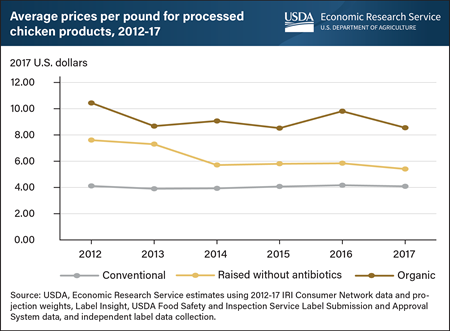
Friday, September 24, 2021
Processed chicken products whose labels show they were raised without antibiotics (RWA) were on average $2.23 per pound more expensive than conventional chicken products between 2012 and 2017, representing a 55-percent markup over conventional products. Processed chicken products include fresh or frozen chicken products that are cooked, marinated, breaded, or fried. A recent USDA, Economic Research Service (ERS) report shows consumer awareness of antibiotic use in meat and poultry production has increased over the past decade, and a growing market has emerged for chicken products that carry an RWA label. Though raising animals without antibiotics can be costly, producers can benefit from doing so when consumers are willing to pay higher prices for RWA products. Analyzing national household scanner data and a constructed dataset of chicken product labels, ERS researchers also found prices for organic processed chicken products were higher than those with RWA labels. From 2012 to 2017, prices for organic processed chicken products were on average $5.13 a pound more than conventional chicken products, representing a 125-percent total markup. These price differences suggest there are significant market opportunities for production practices that fall somewhere between conventional and the standards required for organic production. This information is drawn from the ERS report, The Market for Chicken Raised without Antibiotics, 2012-17, released September 2021.
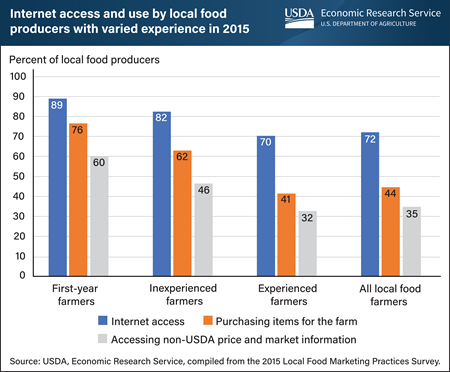
Monday, August 16, 2021
Local food producers had high levels of internet access in 2015 according to a recently released report by USDA, Economic Research Service researchers. They found that 72 percent of local food producers had internet access, either at the farm or at the principal farm operator’s residence. A local food producer is defined as a farming operation that produces and sells edible agricultural products directly to consumers, retailers, institutions, or intermediate markets. Geographic proximity of local food producers to urban areas may account for high levels of internet access. Less-experienced local food producers had greater internet access than those with more farming experience. Eighty-nine percent of first-year farmers had internet access, compared with 82 percent of inexperienced farmers (2 to 10 years of farming experience) and 70 percent of experienced farmers (more than 10 years of farming experience). In 2015, the most popular use of the internet by all local food producers was to buy items for the farm (44 percent of producers), including input supplies, commodities, and equipment. A larger share of first-year farmers used the internet to buy farm inputs (76 percent) and access price and market information from non-USDA sources (60 percent), followed by inexperienced farmers (62 percent and 46 percent, respectively) and experienced farmers (41 percent and 32 percent, respectively). This information is drawn from the ERS report, “Marketing Practices and Financial Performance of Local Food Producers: A Comparison of Beginning and Experienced Farmers,” released August 10, 2021.
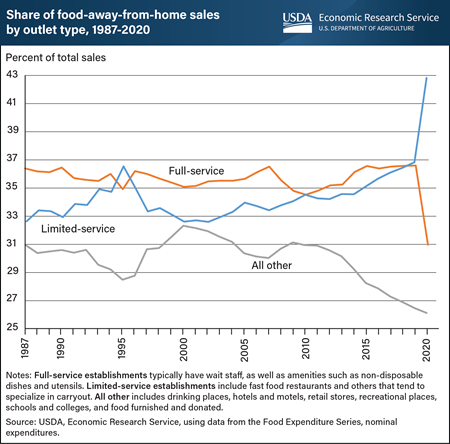
Friday, August 13, 2021
Full-service and limited-service restaurants (fast food restaurants)—the two largest segments of the commercial foodservice market—accounted for 70 percent of all food-away-from-home (FAFH) spending on average from 1987 to 2020. Consumers spent the other 30 percent at places such as hotels and schools. Full-service restaurants had the highest share of FAFH sales in every year of that period except 1995, 2010, 2019, and 2020. In 2020, the share of sales at full-service restaurants dropped from 36.5 percent in 2019 to 31 percent, resulting from a 29.4 percent decline in sales, partly because of safety closures during the Coronavirus (COVID-19) pandemic. Full-service establishments typically have wait staff and other amenities such as ceramic dishware, non-disposable utensils, and alcohol service. In contrast, limited-service restaurants, use convenience as a selling point; they have no wait staff, menus tend to be smaller, and dining amenities are relatively sparse. Given their minimal physical interactions with customers, fast food restaurants adapted to COVID-19 restrictions more quickly during 2020 and assumed a larger share of total FAFH sales at 42.7 percent, compared with 36.8 percent in 2019. Despite the increase in the relative share of FAFH sales, fast food sales decreased by 3.6 percent in 2020 compared with 2019. All other FAFH establishments, such as school and college cafeterias, reported a 17.9 percent decline in sales in 2020 and accounted for 26.3 percent of total FAFH sales. This chart appears on the USDA, Economic Research Service’s Market Segments topic page and its data come from the Food Expenditure Series data product.
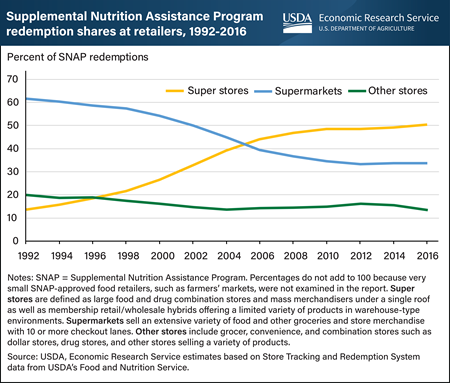
Wednesday, August 4, 2021
Since 2006, super stores received more USDA, Supplemental Nutrition Assistance Program (SNAP) redemptions than any other type of store, totaling half of all redemptions in 2016. SNAP participants can redeem benefits to buy food items at super stores, supermarkets, grocery stores, and other types of approved food retailers. Super stores are defined as large food and drug combination stores and mass merchandisers under a single roof as well as membership retail/wholesale hybrids offering a limited variety of products in warehouse-type environments. USDA, Economic Research Service (ERS) researchers examined the effects of entrant super stores on the survival of existing SNAP-approved stores and their revenue from redeemed benefits. Researchers found that when one super store entered a market area from 1994 to 2015, about 0.25 supermarkets and 0.05 other smaller food retailers on average left over the first three years after entry. Overall store availability did not decline though, as the entry of one super store more than offset the loss of supermarkets and other smaller food retailers in the markets. The ERS researchers estimated that from 1994 to 2005, local supermarkets and other smaller food retailers annually lost $191,000 on average in SNAP redemptions for each super store entrant into their local market. That loss increased to $213,000 on average from 2005–15. At the same time, super stores gained much more in SNAP redemptions than was lost at local food retailers, leading the researchers to conclude that SNAP beneficiaries shifted purchases to super stores. Based on previous research showing that food is about 3 percent less costly at super stores, the researchers estimated that a shift of SNAP redemptions to super stores expanded the purchasing power of SNAP participants’ benefits by $108.6 million in 2015 (0.15 percent of total SNAP benefits and costs in 2015).This chart appears in the ERS’ Amber Waves article, “New Super Stores Slightly Expanded Purchasing Power for Participants in USDA’s Supplemental Nutrition Assistance Program (SNAP),” June 2021.
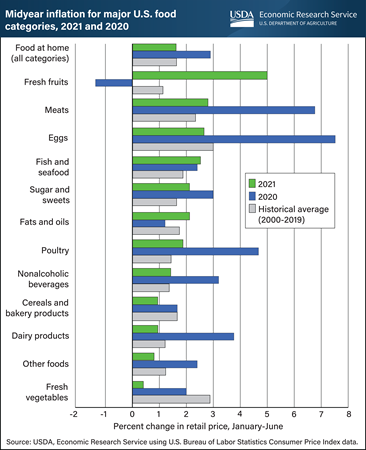
Wednesday, July 28, 2021
Retail food prices have increased 1.6 percent in the first six months of 2021, less than the rate over the same period last year (2.9 percent) and equal to the historical average over the same six months from 2000 to 2019. Of the 13 food categories depicted in the chart, 10 have experienced slower price increases so far in 2021 compared with halfway through 2020, while 5 categories trailed their historical midyear average price increases. In the first six months of 2021, prices for five food categories increased at a rate slower than in 2020 and years prior: eggs, dairy, fresh vegetables, cereals and bakery products, and “other foods.” Conversely, prices for three food categories increased in the first six months of 2021 at a rate faster than in 2020 and in years prior: fresh fruits (4.8 percent), fish and seafood (2.5 percent), and fats and oils (1.9 percent). Inflationary pressures differ by food category. For example, fresh fruit prices currently are increasing more than four times faster than their historical average rate because of low citrus supplies and increased exports. Prices may change during the remainder of 2021; in the second half of 2020, prices increased for all food categories except eggs and the category of beef and veal. USDA, Economic Research Service (ERS) researchers project food-at-home prices will increase between 2 and 3 percent in 2021. Forecasts for all food categories, including for 2022, are available in ERS’s monthly Food Price Outlook data product, updated July 23, 2021.
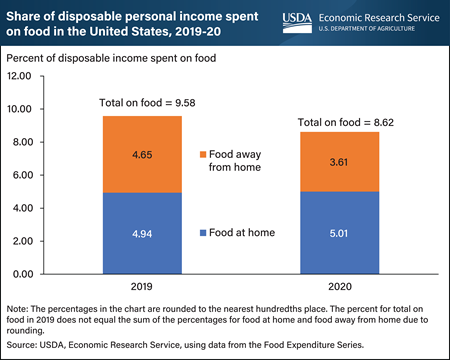
Friday, July 2, 2021
During the Coronavirus (COVID-19) pandemic and economic recession in 2020, the share of U.S. consumers’ disposable personal income (DPI) spent on food decreased 10.1 percent from the previous year to 8.62 percent, the lowest share in the past 60 years. DPI is the amount of money that U.S. consumers have left to spend or save after paying taxes. The share of DPI spent on food in the United States was relatively steady over the last 20 years, decreasing from 9.95 percent in 2000 to 9.58 percent in 2019. Consumers spent 1.4 percent more of their incomes on food at supermarkets, convenience stores, warehouse club stores, supercenters, and other retailers (food at home) from 2019 to 2020, while they spent 22.2 percent less of their incomes on food at restaurants, fast-food places, schools, and other places offering food away from home over the same period. Changes in the shares of income spent on food in 2020 resulted, in part, from pandemic-related closures and restrictions at food-away-from-home establishments, as well as from the largest annual DPI increase in 20 years. The increase in DPI was driven by additional Government assistance to individuals in 2020, including stimulus payments to households and increased unemployment insurance benefits. The data for this chart come from the Economic Research Service’s Food Expenditure Series data product. See also the Amber Waves article Average Share of Income Spent on Food in the United States Remained Relatively Steady from 2000 to 2019, published in November 2020.
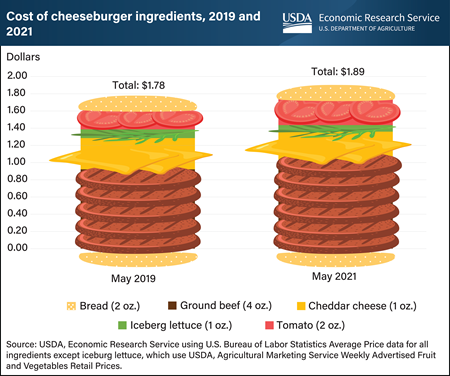
Tuesday, June 29, 2021
For Fourth of July cookouts this year, cheeseburgers could be a bit pricier than they were in 2019. The latest available prices from May 2021 show the ingredients for a home-prepared quarter-pound cheeseburger totaled $1.89 per burger, with ground beef making up the largest cost at $1.03 and cheddar cheese accounting for $0.34. This same cheeseburger would have cost $1.78 to prepare in May 2019, an increase of 6.3 percent. Retail prices for one-pound quantities of all ingredients, except tomatoes, were higher in May 2021 compared with May 2019. USDA, Economic Research Service (ERS) is using 2019 for comparison because 2020 was an unusual year for food prices. Higher ground beef prices accounted for more than half the 11-cent increase between 2019 and 2021, while cheddar cheese costs were 1 cent more per burger in May 2021. Bread and iceberg lettuce prices rose the fastest—17.2 and 11.4 percent, respectively—but these ingredients represented a relatively small portion of the total cost of a burger. Bread and lettuce added 4 cents to a burger’s total cost in 2021. Tomato prices remained roughly the same over this period. This chart uses data from the ERS Food Price Outlook data product.
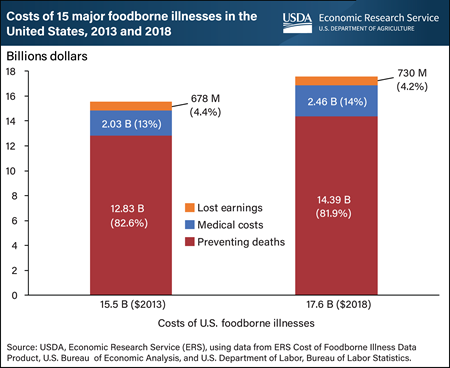
Monday, June 21, 2021
The USDA, Economic Research Service (ERS) estimates that inflation and income growth drove up the costs resulting from 15 foodborne illnesses in the United States by $2 billion from $15.5 billion in 2013 to $17.6 billion in 2018. For this estimate, ERS included medical care costs, the value of lost earnings, and a monetary measure of death based on individuals' willingness to pay to reduce the risk of dying from foodborne illness. The biggest factor behind the increase in the overall costs of foodborne illnesses was the effect of inflation and income growth on the value people place on preventing deaths. However, the value of prevented deaths as a share of overall costs decreased slightly in 2018 compared to 2013 due to the substantial inflation in medical costs. Health effects from foodborne illness can vary by pathogen (bacteria, viruses, and parasites), ranging from a few days of diarrhea to more serious outcomes, such as kidney failure, cognitive impairment, and even death. Determining the overall costs of these health effects provides a common metric to compare impacts of different pathogens, a way to aggregate impacts across illnesses, and a means of comparing the costs of experiencing those illnesses with the costs of preventing them. More information can be found in the ERS’s updated Cost Estimates of Foodborne Illnesses data product. This chart appears in the ERS’s Amber Waves article, “Economic Cost of Major Foodborne Illnesses Increased $2 Billion From 2013 to 2018,” April 2021.
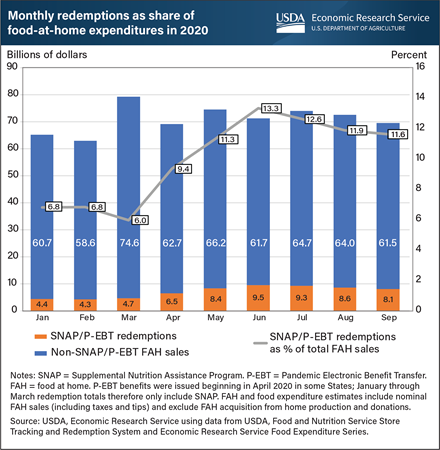
Monday, June 7, 2021
Shutdowns, stay-at-home orders, and the need for social distancing led households to buy more food for consumption at home during the Coronavirus (COVID-19) pandemic. In response to the economic downturn and pandemic conditions, supplemental emergency allotments were issued to Supplemental Nutrition Assistance Program (SNAP) households and Pandemic Electronic Benefit Transfer (P-EBT) benefits were distributed to households with children missing free and reduced-price school meals. This expansion of nutrition assistance led to a rapid increase in the dollar amount of these benefits issued to households and redeemed for food at home (FAH). In January and February 2020, SNAP benefit redemptions accounted for 6.8 percent of total FAH expenditures as estimated by the Food Expenditure Series. In March 2020, FAH spending spiked, causing SNAP’s share of FAH spending to fall. From March to June 2020, the introduction of P-EBT and increase in SNAP benefits led to rapid growth in these programs’ share of FAH spending. In June 2020, redemptions of these benefits peaked at $9.5 billion—making up 13.3 percent of FAH spending that month. This share fell the following three months. Overall, the share of total FAH spending attributable to SNAP and P-EBT from April through September 2020 was 11.7 percent—more than one in nine dollars and nearly 5 percentage points higher than SNAP’s share over the same months in 2019. This chart is based on a chart in the USDA, Economic Research Service’s COVID-19 Working Paper: Supplemental Nutrition Assistance Program and Pandemic Electronic Benefit Transfer Redemptions during the Coronavirus Pandemic, released March 2021.
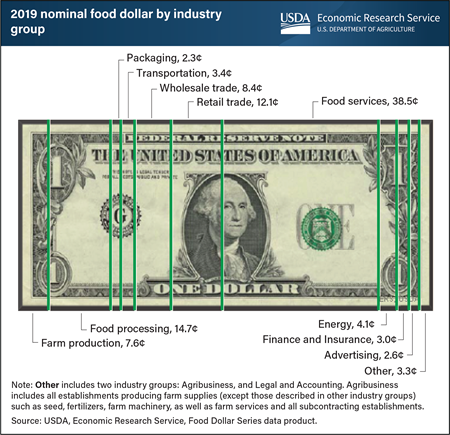
Monday, May 17, 2021
In 2019, restaurants and other eating places claimed 38.5 cents of the average U.S. food dollar, continuing a steady climb since 2009, when the food services industry’s share was 29.6 cents. Farm production was the only other industry with a rising food dollar share in 2019, up slightly to 7.6 cents from its 25-year low of 7.4 cents in 2018. The proportion of the food dollar was the smallest since 1993 for several industries in 2019: agribusiness (such as fertilizer and farm services), food processing, packaging, wholesale trade and retail trade. The 2019 food dollar reflects conditions before the COVID-19 pandemic. ERS’s annual Food Dollar Series provides insight into the industries that make up the U.S. food system and their contributions to total U.S. spending on domestically produced food. ERS uses input-output analysis to calculate the cost contributions from 12 industry groups in the food supply chain. Annual shifts in the food dollar shares between industry groups occur for a variety of reasons, including changes in the mix of foods consumer buy, costs of materials, ingredients, and other inputs, as well as changes in the balance of food at home and away from home. This chart is available for the years 1993 to 2019, and can be found in ERS’s Food Dollar Series data product, updated on March 17, 2021.
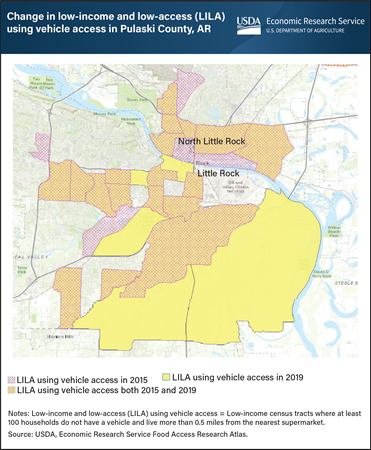
Wednesday, April 28, 2021
The USDA, Economic Research Service’s (ERS) Food Access Research Atlas provides a map of neighborhoods with limited access to nutritious, affordable food for the entire United States. Limited access to high-quality, low-cost food may impede some consumers from achieving a healthy diet. The updated Atlas allows users to map low-income and low-supermarket access census tracts for 2019 and compare the results with those for 2015. Individuals can choose to display one or several of the measures of low-supermarket access that are based on residents’ distances from the nearest supermarket (more than 0.5 or 1 mile in urban areas or more than 10 or 20 miles in rural areas) and whether a substantial number of households have access to a vehicle. One measure considers a tract to be low-income and low-access (LILA) if it is low-income and contains a substantial number of vehicle-less households that live more than 0.5 miles from the nearest supermarket. Using this measure, the number of low-income and low-access census tracts in Pulaski County, Arkansas, for example, rose 4 percent from 2015 to 2019. Twenty-three percent of Pulaski County households lived in these tracts in 2019, including 6 percent who lived more than 0.5 miles from a supermarket and did not have a vehicle. This map was created using ERS’s Food Access Research Atlas, updated April 27, 2021.
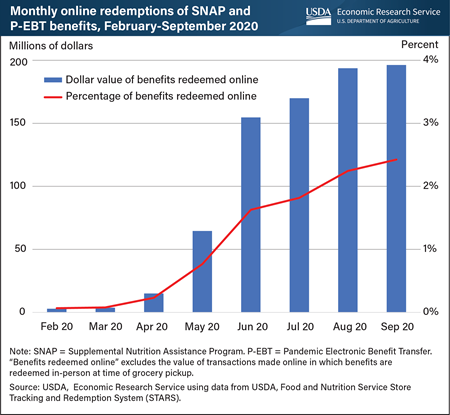
Friday, April 16, 2021
The Supplemental Nutrition Assistance Program (SNAP) Online Purchasing Pilot began in 2019 as mandated by the 2014 Farm Act and was quickly expanded in 2020 in response to the COVID-19 pandemic. The pilot allows households in participating States to use their SNAP benefits to purchase groceries online from a limited number of authorized retailers. Households can similarly use Pandemic Electronic Benefit Transfer (P-EBT) benefits, which were issued in 2020 to households with children missing free and reduced-price school meals during the pandemic. Online transactions using benefits are subject to the same requirements as in-person transactions and cannot be spent on tips or fees. The number of States where SNAP and P-EBT benefits could be redeemed online grew from just one State at the beginning of 2020 to 46 States by the end of September 2020. As availability increased and the pandemic necessitated continued social distancing, the value of SNAP and P-EBT benefits redeemed online increased. In February 2020, households redeemed less than $3 million in benefits online, accounting for less than 0.1 percent of all benefits redeemed. By September, this amount grew to $196 million — 67 times its value in February. Overall, households redeemed $801 million in benefits online from February to September 2020. Despite this rapid growth, online redemptions accounted for only 2.4 percent of all benefits redeemed in September. This chart is based on a chart in the USDA, Economic Research Service’s COVID-19 Working Paper: Supplemental Nutrition Assistance Program and Pandemic Electronic Benefit Transfer Redemptions during the Coronavirus Pandemic, released March 2021.
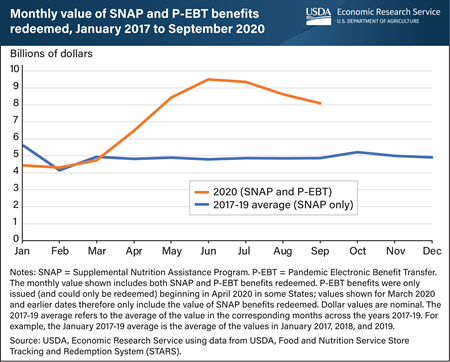
Thursday, April 8, 2021
The U.S. Government expanded existing food assistance programs and introduced new ones in response to the COVID-19 pandemic and subsequent economic contraction in the United States in 2020. Some States began issuing monthly supplemental emergency allotments to Supplemental Nutrition Assistance Program (SNAP) households in March 2020, with the rest beginning to do so in April 2020. All States issued Pandemic Electronic Benefit Transfer (P-EBT) benefits to households with children who missed free or reduced-price school meals during the 2019-20 school year; the earliest States began issuing P-EBT benefits in April 2020. This led to a rapid increase in the dollar amount of food assistance benefits issued to households and redeemed for groceries during the pandemic. The value of total monthly redemptions roughly doubled from $4.7 billion in March 2020 to $9.5 billion in June 2020. Most P-EBT benefits for the 2019-20 school year were issued in May and June 2020, leading total redemptions to peak in June and decline over the next three months. By September, redemptions amounted to $8.1 billion. Overall, an average of $8.4 billion per month in combined SNAP and P-EBT benefits were redeemed from April through September 2020—an increase of 74 percent compared with the average value of benefits redeemed during the same 6 months in 2017-19. This chart is based on a chart in the USDA, Economic Research Service’s COVID-19 Working Paper: Supplemental Nutrition Assistance Program and Pandemic Electronic Benefit Transfer Redemptions during the Coronavirus Pandemic, released March 2021.


